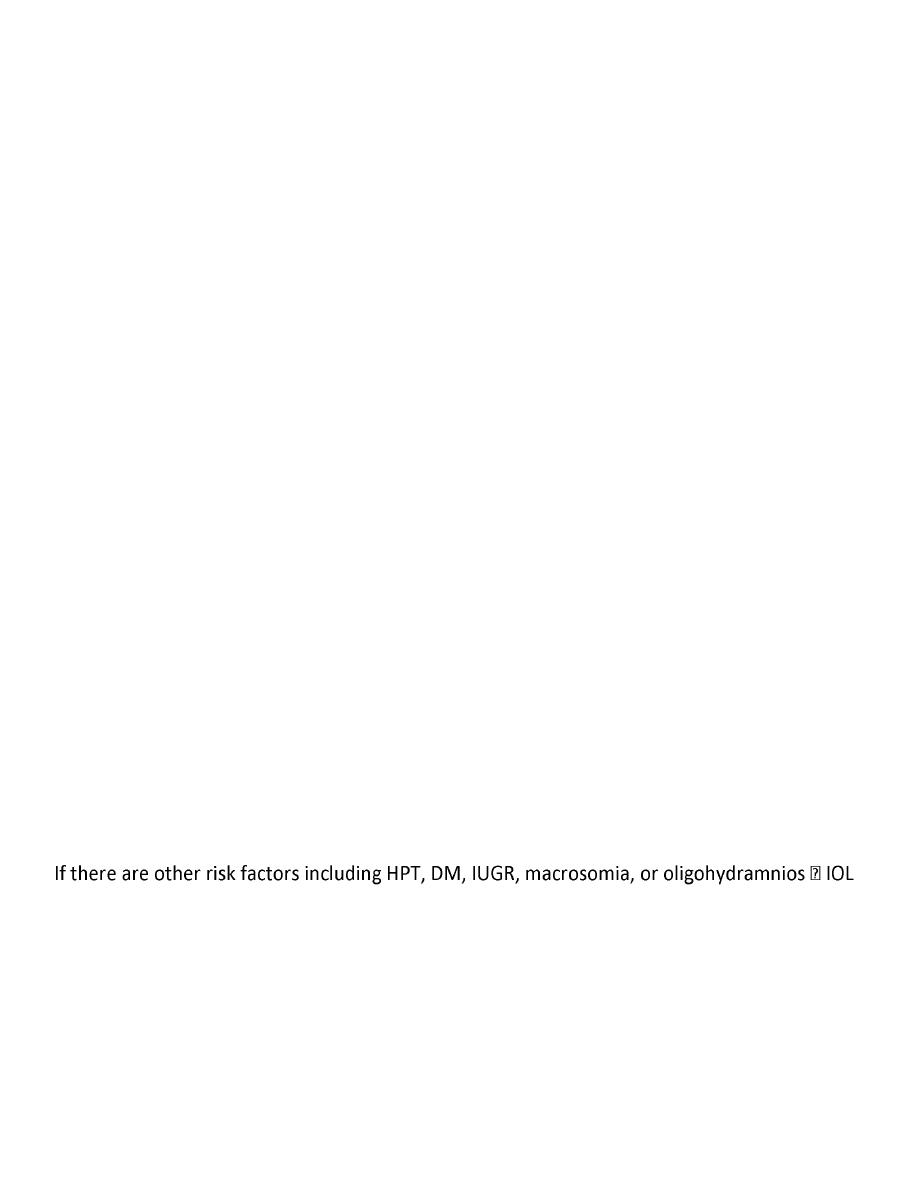
obstetrics
dr.aseel
Post-term Pregnancy
DEFINITION
Post term:
refers to a pregnancy that has extended to or beyond a gestational age of 42wks or
294ds from the 1st day of the LMP.
Postdatism
: is pregnancy lasting beyond the estimated due date at 40 weeks.
Postmature:
specific syndrome assosciated with postterm preg in which the fetus experiences
placental insufficiency and resultant IUGR .
Etiology:
The most frequent cause is an error in dating.
Maternal factors : genes influence prolonged pregnancy
,primiparity , irregular ovulation.
Fetal-placental factors
- anencephaly
- adrenal hypoplasia
- X-linked placental sulfatase deficiency
- A lack of the usually high estrogen levels of normal pregnancy
-male sex
PHYSILOGICAL CHANGES WITH POSTTERM GESTATION.
PLACENTAL CHANGES :
senescence/ageing (increased grading on ULS) infarcts , calcification
AMNIOTIC FLUID CHANGES
: Oligohydramnios (diminished fetal urination) cloudy ( vernix)
presence of meconium
FETAL CHANGES :
45%-Macrosomia 20%-IU malnutrition
Incidence:
Using the definition of 294 days, the incidence of postterm pregnancy is 10%

obstetrics
dr.aseel
COMPLICATIONS:
MATERNAL
1Anxiety.
2-Traumatic vaginal delivery-vaginal & perneal tear
3-Increased CS rate
4-PPH
FETAL
1-Fetal distress
2-Meconium aspiration
3-Fetal trauma
4- brachial plexus injuries, clavicle fracture
5-Increased prenatal mortality
6-Dysmaturity syndrome.
MANAGEMENT:
A/ CONFIRMATION OF GESTATIONAL AGE
1.History:
Reliable LMP if Sure date , No OCP ,abortion ,lactation for the last 3 ms, Regular cycles &
length of the cycle(not all women have 28 day cycles, and not all women ovulate on day 14 of
their cycle.).
Quickening primi gravida typically notice movement around 18-20 weeks. Mothers who have
been pregnant before notice it as early as 16 weeks.
2. Examination:
First trimester P/V examination (ut size goes with date)

obstetrics
dr.aseel
Fundal Height : can be a rough estimate of gestational age.
Typically, from week 24 to week 34, fundal height in centimetres correlates with weeks of
gestation.
3. FHT heard by fetoscope 18-20 wks.
4-ultrasound:
confirm or establish GA if unreliable LMP or ut size is inconsistent with GA
First trimester CRL(+/-5d)
Second trimester BPD 12-20w (+/- 7d),20-30(+/-2w)
In the third trimester, the accuracy of ultrasound in predicting the due date is less, with a +/-
confidence range of as much as 3 weeks.
B/Absence/presence of maternal & fetal risk factors.
1-Maternal diseases :-
- Diabetes.
- Hypertension \ renal diseases.
- cardiac disease.
- Bad obestetrical history
2-pregnancy – related conditions:-
-pre eclampsia.
- intra hepatic choleostasis of pregnancy.
- APH at term.
3-fetal indication:-
- intra uterine growth restricted or macrosomia.
- oligohydramnious.
- Iso immunization.

obstetrics
dr.aseel
C/Establish how favorable cervix is
(BISHOP score) & if there is contraindications to labor or vaginal delivery)
Previous myomectomy entering the cavity
Fetal transverse lie
Placenta previa
Contracted pelvis
Previous classical
2 or more CS
D/Assess fetal well-being
Fetal movement counts (Not less than 10 movement per 12 hours).
Non stress test (Cardiotocography)
Biophysical Profile
Amniotic Fluid Volume estimates
Doppler Ultrasound
Management 39-40 wks+6d
In uncomplicated pregnancies there is no evidence to support IOL nor fetal surveillance if the
initial assesment of fetal wellbeing was reassuring
or serial fetal suvillence is indicated
Management at 41 weeks gestation
-Inducing labour at 41-42 weeks gestation or Awaiting the onset of spontaneous labour ,
while monitoring the fetal wellbeing .
-A Healthy, uncomplicated pregnancy
- Establish the cervical (Bishop) Score if faviorable

obstetrics
dr.aseel
-Inform the woman of the options and risks/ benefits of labour induction versus expectant
management, and offer her labour induction.
Management at 41 weeks gestation:
-If mother declines induction ,or un faviorable cx then provide expectant management:
- Daily fetal movement counts
- Non stress test (NST) and Amniotic fluid index (AFI) or BPP twice/ week to 42 weeks.
- If the NST or AFI is abnormal, Prostaglandin can be used to promote cervical ripening and
induce labor.
Induce at 42 weeks even if NST and AFI are normal:
INTRAPARTUM MANAGEMENT:
-Left lateral position
-Continuous electronic fetal monitoring
-Early ARM in active phase (hastens progress, detects meconium)
-LSCS if CPD/macrosomia, fetal distress
- Be aware of shoulder dystocia and Paediatrician called at delivery for neonatal resuscitation.
Post maturity syndrome
Associated with oligohydramnios meconium ,fetal distress & IUGR
Wrinkled, peeling skin on the palms and soles
Long, thin body suggesting wasting
Long nails & hair
Open-eyed, unusually alert, old & worried-looking face
Incidence : 20% of pregnancies between 41and 43 weeks.

obstetrics
dr.aseel
VITAL STATISTICS:
MATRNAL MORTALITY
It is the maternal death which can be attributed to pregnancy & childbirth i.e the death of a
woman while pregnant, or within 42 days of termination of pregnancy (due to direct or
indirect causes) .
Maternal death can be due to:
1- direct cause from complications of pregnancy or labour such as bleeding, fits, and infection.
2- Indirect: resulting from a previously existing disease that is aggravated by the physiological
effects of pregnancy e.g. mitral stenosis
3- Fortuitous deaths: death among healthy women who were pregnant at the time of death,
the cause was not related to the pregnancy, e.g. road traffic accidents. This category has been
excluded from internationally defined maternal mortality.
Maternal mortality ratio:
Number of maternal deaths during a given time period per 100 000 live births during the same
time period.
Major causes of death:
1. Hemorrhage.
2. Sepsis (infection).
3. Abortion and ectopic pregnancy.
4. Hypertensive disease
5. Obstructed labour.
6.Other direct causes(Pulmonary embolism. . Amniotic fluid embolism).
7. Other indirect causes ( Cardiac disease, Anesthesia).

obstetrics
dr.aseel
Live birth:
complete expulsion of a baby from it is mother irrespective of gestational age,
which shows any signs of life such as breathing, heart beating.
Stillbirth:
birth of a baby, from 24 completed weeks of gestation , who shows no sign of life
after birth. It includes IUD and intra partum death.
Perinatal deaths:
is defined as all still births plus all live born babies that die in the first week of
life regardless of gestational age at birth [early neonatal death].
Neonatal death
-The death of the baby within 28 days following birth, it includes:
-Early neonatal death occurring within one week of birth.
-Late neonatal death from age 7 days to 28 completed days of life.
-Early neonatal mortality rate: number of live born babies dying within the first week of life
per 1000 live births.
-Late neonatal mortality rate: number of live born babies dying from the end of 1st week of
life till the end of the 4th week per 1000 live births.
-Perinatal mortality rate: the number of number of perinatal deaths (stillbirth &early neonatal
death) per 1000 total birth.
Classification of Perinatal mortality causes:
1-Prematurity
2-Congenital malformation
3-Antepartum fetal death (IUGR ,APH , Maternal HT&DM)
4-Intrapartum asphyxia
5-Others (infection, trauma ,hemolytic disease, unexplained)
BY:TWANA NAWZAD
